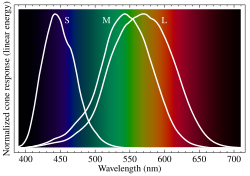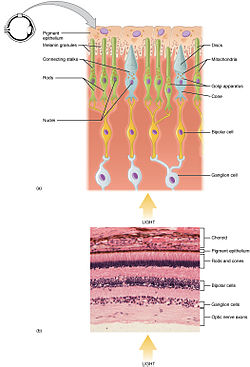Cone cells or cones are photoreceptor cells in the retina of the vertebrate eye. Cones are active in daylight conditions and enable photopic vision, as...
17 KB (1,893 words) - 14:53, 16 April 2025
mammalian eyes: rods, cones, and intrinsically photosensitive retinal ganglion cells. The two classic photoreceptor cells are rods and cones, each contributing...
26 KB (2,939 words) - 18:31, 17 May 2025
As a part of the retina, bipolar cells exist between photoreceptors (rod cells and cone cells) and ganglion cells. They act, directly or indirectly, to...
7 KB (752 words) - 03:51, 12 May 2025
Rod cells are photoreceptor cells in the retina of the eye that can function in lower light better than the other type of visual photoreceptor, cone cells...
14 KB (1,753 words) - 09:32, 12 March 2025
M cone cells. It is impossible to view under normal viewing conditions, due to the overlap between the wavelengths of light which stimulate M cone cells...
6 KB (642 words) - 21:57, 12 June 2025
channels for conveying color information, or possessing four types of cone cell in the eye. Organisms with tetrachromacy are called tetrachromats. In...
26 KB (2,781 words) - 21:46, 22 May 2025
mice lacking rod and cone cells still responded to changing light levels through pupil constriction; this suggested that rods and cones are not the only light-sensitive...
27 KB (3,120 words) - 16:02, 26 May 2025
Photopic vision (redirect from Cone cell vision)
many other animals, photopic vision allows color perception, mediated by cone cells, and a significantly higher visual acuity and temporal resolution than...
4 KB (403 words) - 19:25, 24 April 2025
light spectrum with three types of cone cells (trichromacy). Other animals may have a different number of cone cell types or have eyes sensitive to different...
59 KB (7,037 words) - 09:20, 28 May 2025
conveying color information, derived from the three different types of cone cells in the eye. Organisms with trichromacy are called trichromats. The normal...
15 KB (1,634 words) - 06:20, 25 May 2025
Color vision (section Cone cells in the human eye)
up: Perception of color begins with specialized retinal cells known as cone cells. Cone cells contain different forms of opsin – a pigment protein – that...
65 KB (7,921 words) - 02:41, 24 April 2025
Double cones (DCs), known as twin cones when the two members are the same, are two cone cells (colour detecting photoreceptors) joined together that may...
3 KB (382 words) - 20:30, 19 May 2025
A cone dystrophy is an inherited ocular disorder characterized by the loss of cone cells, the photoreceptors responsible for both central and color vision...
11 KB (1,318 words) - 20:17, 4 May 2025
about color by processing signals from cone and rod cells in an antagonistic manner. The three types of cone cells have some overlap in the wavelengths...
25 KB (3,085 words) - 04:04, 13 June 2025
Achromatopsia (section Blue cone monochromacy)
in the cone cell cyclic nucleotide-gated ion channels CNGA3 (ACHM2) and CNGB3 (ACHM3), the cone cell transducin, GNAT2 (ACHM4), subunits of cone phosphodiesterase...
29 KB (3,221 words) - 12:39, 9 June 2025
may imply that they have been modified from a cone cell ancestor. They occasionally occur in double cones/double rods. Some oil droplets are coloured,...
3 KB (330 words) - 18:26, 16 February 2024
The list of human cell types provides an enumeration and description of the various specialized cells found within the human body, highlighting their...
35 KB (1,773 words) - 00:20, 19 May 2025
are characterised by initial loss of rod photoreceptor cell function followed by that of the cones and for this reason night blindness is the first significant...
12 KB (1,586 words) - 13:32, 19 March 2025
Fovea centralis (section Angular size of foveal cones)
belt, where the ganglion cell layer is composed of more than five layers of cells, as well as the highest density of cones; the perifovea is the outermost...
26 KB (3,013 words) - 18:55, 25 May 2025
Vertebrate visual opsin (redirect from Cone opsin)
mediate vision in vertebrates. They include the opsins in human rod and cone cells. They are often abbreviated to opsin, as they were the first opsins discovered...
10 KB (1,049 words) - 20:10, 23 May 2025
vision is trichromatic, which is enabled by three classes of cone cells (L, M & S). Each cone class contains a slightly different photopsin with a different...
57 KB (7,850 words) - 01:11, 7 June 2025
protects the cone cells from apoptosis. When these rod cells die, this substance is no longer provided. This is generally followed by the loss of cone photoreceptor...
63 KB (6,350 words) - 22:04, 29 May 2025
Peripheral vision (section Cone-rich rim of the retina)
distribution of receptor cells across the retina is different between the two main types, rod cells and cone cells. Rod cells are unable to distinguish...
25 KB (2,864 words) - 05:46, 17 June 2024
four types of cone cells each with a distinctive maximal absorption peak. In some birds, the maximal absorption peak of the cone cell responsible for...
68 KB (8,335 words) - 02:50, 25 May 2025
the eye reports input from short wave blue cone cells along with a sub-sensitivity of the long wave cones which respond secondarily to that same deep...
21 KB (2,368 words) - 17:03, 10 June 2025
is the state of having two types of functioning photoreceptors, called cone cells, in the eyes. Organisms with dichromacy are called dichromats. Dichromats...
16 KB (1,716 words) - 07:00, 30 April 2025
Look up cone or coning in Wiktionary, the free dictionary. A cone is a basic geometrical shape. Cone may also refer to: Cone (category theory) Cone (formal...
4 KB (647 words) - 20:02, 3 June 2025
Color blindness (section Based on affected cone)
variation in the functionality of one or more of the three classes of cone cells in the retina, which mediate color vision. The most common form is caused...
99 KB (10,465 words) - 15:10, 5 June 2025
and/or green opsin proteins, which are the photosensitive pigment in the cone cells of the retina, which mediate color vision. Males are more likely to inherit...
36 KB (3,281 words) - 16:42, 9 January 2025
Eye (section Rods and cones)
project onto a light-sensitive layer of cells known as the retina. The cone cells (for colour) and the rod cells (for low-light contrasts) in the retina...
59 KB (7,524 words) - 04:38, 26 May 2025





















